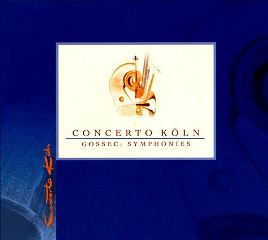François-Joseph Gossec - Symphonies (Concerto Köln) [2003]
François-Joseph Gossec - Symphonies (Concerto Köln) [2003]

Symphony in C minor, Op. 6, No. 3 1 I. Allegro 00:05:08 2 II. Minuetto gratioso 00:04:37 3. Fugato 00:03:43 Symphonie a grand ochestre in D major, Op. 13, No. 3, "La Chasse" 4 I. Grave maestoso - Allegro 00:04:26 5 II. Allegretto poco allegro 00:03:10 6 III. Minuetto 00:03:17 7 IV. Tempo di caccia 00:03:37 Symphonie concertante in D major, "Mirza" 8 I. Allegro 00:01:16 9 II. Adagio 00:03:56 10 III. Rondo allegro 00:05:56 Symphonie a 17 parties 11 I. Maestoso - Allegro molto 00:05:41 12 II. Larghetto 00:06:31 13 III. Minuetto 00:07:06 14 IV. Allegro assai Martin Sandhoff – flute Andrea Keller – violin Concerto Köln Werner Erhardt – conductor Andrea Keller -conductor
One of the leading figures of eighteenth century French music, Gossec was a versatile and prolific composer—particularly of instrumental music, as exemplified by his symphonies and string quartets. He enlarged the expressive capabilities of the orchestra, relying on his harmonic imagination and sense of sound texture; in many ways his experiments presage the works of Haydn and Beethoven. His choral music is also significant; his Te Deum, for example (written for 300 instrumentalists and a choir of more than 1,000 singers), foreshadows the later works of Berlioz.
Born in the historic Hainaut region (an incubator of great composers all the way back to the Renaissance), Gossec started his musical studies on the violin and the harpsichord. In 1741, he joined the choir of the Notre Dame Cathedral in Antwerp, continuing his music studies. In 1751, Gossec went to Paris, armed with a letter of introduction to Rameau. The composer was so impressed by Gossec that he found him a position as violinist and bass player in the famous orchestra of La Pouplinière, conducted by Johann Stamitz (of Mannheim fame—thus his affinity for the emerging symphonic form). During this period, he produced large quantities of symphonic and chamber music; Gossec's symphonies composed in the 1750s and 1760s (mostly the three-movement Italianate variety) displayed an extraordinary range of form and orchestration.
In 1762 Louis-Joseph de Bourbon, Prince of Conde, appointed Gossec director of his private theater; however, despite some success, Gossec's operas did not show the same promise as his instrumental works. Gossec founded a new orchestra, the Concert des Amateurs, in 1769. This extraordinary ensemble attracted the best musicians of the time and performed many of Gossec's own symphonies, including his immensely popular La chasse. During his final season as director Gossec conducted the first performance of a symphony by Haydn in France.
In 1773, Gossec left the Concert des Amateurs, assuming the leadership of the Concert Spirituel. In addition, he worked for the Opéra, supervising the production of contemporary works. In 1774, Gossec's oratorio La nativité was performed at the Concert Spirituel. Among the innovations introduced in this work was a choir of angels, which Gossec put offstage, a device which Berlioz used in his oratorio L'Enfance de Christ (1854).
In 1780, Gossec obtained the post of sous-directeur of the Opéra, assuming the directorship, four years later, of the newly founded Ecole Royale de Chant, which was under the Opéra's administrative control. During this period, Gossec continued composing symphonies, also writing works for the stage, including ballets, which were not very successful.
Unlike Cherubini, Gossec quickly adapted to the new cultural climate in the wake of the French Revolution. In 1789, he severed all his ties with the Opéra, which the revolutionary government regarded as a royalist institution. In addition, he placed his talent as a composer in the service of the new regime, composing popular pieces and organizing musical events to celebrate the Revolution. Prominent among Gossec's politically motivated composition is his massive Te Deum (1790), written to commemorate the storming of the Bastille.
While Gossec's output drastically diminished after 1800, works written during his final creative period include important works such as Symphonie a 17 parties (1809) and Derniere messe des vivants (1813).
Because of his enthusiastic support for the Revolution, Gossec was not treated well by the restored French monarchy. In 1816, King Louis XVIII dissolved the Conservatoire, which he doubtless perceived as an institution created by the Revolution, and Gossec was left without employment. He eventually moved to Passy, then a suburb of Paris, where he spent his remaining years. --- Zoran Minderovic, All Music Guide








